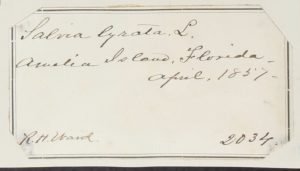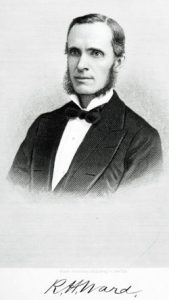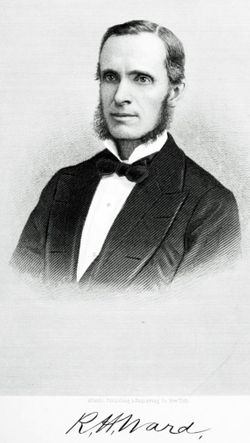(17 June 1837 – 28 October 1917)
“We shall do poor work, indeed, if we do not make the microscope not only a source of pleasure to ourselves,
but of more serious profit to science and to humanity.”
R. H. Ward, 1878 6
The University of North Carolina at Chapel Hill Herbarium (NCU) curates four vascular plant specimens collected by Richard Halsted Ward, M.D. He consistently signed herbarium labels as “R. H. Ward, M.D.” All Ward’s specimens which have been cataloged thus far in our collection date from March and April, 1857, were collected in Florida, and were amongst specimens transferred to NCU in 2002 from Dartmouth College (HNH). These specimens were most likely collected while Ward was an undergraduate participant of the 1857 Florida Expedition by the Lyceum of Natural History of Williams College, Berkshire County, Massachusetts.

“The Lyceum of the Natural History held a levee at their rooms this evening, for the purpose of exhibiting the specimens of various kinds obtained by the late Florida Expedition, which was sent out under the auspices of the Society. The collection consisted principally of corals, shells, birds and fish. The company also obtained two small alligators, two gophers, which are now living, although not having eaten anything for several weeks; a porpoise and a shark, and many other curiosities. Scientific men throughout the country have taken great interest in this expedition and have contributed much to defray expenses, and in return will receive portions of what was obtained.”7
Dr. Ward collected throughout the United States and Canada. Other herbaria curating specimens collected by Dr. R. H. Ward include University of Illinois at Urbana-Champaign (ILL; bryophytes and vascular from Iowa, Massachusetts, New Hampshire, Minnesota, Michigan, New York, Connecticut and Quebec); Field Museum (F; plants collected in Florida, Massachusetts, Minnesota, Pennsylvania and New York); and the Chicago Academy of Sciences (CACS; a specimen collected in Massachusetts). As more herbaria continue to catalog collections it is likely that more specimens collected by Ward will be found.1,3
Ward joined the Botany Department at Rensselaer Polytechnic Institute in 1867.2

“R. Halsted Ward, A.M. , M.D., F.R.M.S., was born in Bloomfield, Essex County, N.J. [New Jersey, United States of America], June 17th, 1837. He was the eldest son of Israel C. and Almeda H. Ward. After a preparatory course in the local schools, he entered Williams College at the age of seventeen, and was graduated at twenty-one. (A.B. in 1855; A.M. in 1861.) While in college he was president of the Philotechnian Literary Society, editor of the Williams Quarterly, and a most active member of the “Florida Expedition” (1857), one of the first and most successful of the parties that have been sent out from various colleges for the purpose of scientific study and collection.
After a thorough course of study in the medical schools and hospitals of New York and Philadelphia (M.D. from College of Physics and Surgery, New York, 1862), a short service in the United States military hospital at Nashville, Tenn. [Tennessee], and a short residence, as a sanitary measure, in Minnesota, he established in Troy [New York], in 1863, the system of family medical practice which has been maintained uninterruptedly ever since. He is a member of the Rensselaer County Medical Society (president in 1877, and re-elected in 1878); of the American Medical Association, and was a delegate to the International Congress, held in London in 1881. Several of his papers on medical subjects have been published in the transactions of the Medical Board (since 1868), and of the Board of Governors (since 1868, and secretary since 1883), of the Marshall Infirmary.
His scientific work, outside the medical profession, originated from a fondness while in college for botany, biology and microscope, and has maintained the same direction ever since. He was appointed instructor of botany at the Rennselaer Polytechnic Institute in 1867, and was made professor of botany the following year. He has also delivered courses of lectures on microscopy at the Institute on several occasions, and is lecturer on microscopy in the scientific course lately established. Outside the Institute his scientific lectures have been numerous, and have seldom failed to touch in some way his favorite subject of the practical applications of science.
His original work in the advancement of science has been mostly in the direction of microscopy, in which he was among the first to apply the microscope to the discrimination of different kinds of blood in connection with criminal trials, and to the detection of forgery, erasures, and other falsifications in handwriting. Besides introducing the microscope as a critical element in many important criminal trials, he has made it prominent and important in many legal, medical, sanitary and economical cases pertaining to water supply, adulteration of food and medicine, special causes of disease, etc. Finding the existing standards of measurement quite unsatisfactory for work of such precision, he took a leading part in organizing the “National Committee on Micrometry,” and in securing the standard micrometer, which is now acknowledged as authority for such purposes. Among his inventions and contrivances for the improvement of the microscope are an illuminating arrangement for binoculars, a safety mailing box for slides (used by the Postal Club), an eye shade, the iris illuminator, and a lens holder for dissecting purposes.
Professor Ward is author of the elaborate article on microscopy in Appleton’s Annual Cyclopedia for 1884; and editor, conjointly with Rev. A. B. Hervry, of the American revision of Behrens on the Microscope in Botany, (Boston, 1885), to which work he made extensive critical contributions respecting the microscope and its accessories. His numerous scientific papers, published during the last twenty years, have pertained mostly to such practical subjects as the practical uses of the microscope; medical microscopy; the study of blood and handwriting; micrometry; illumination; the powers, aperture and nomenclature of objectives and oculars; student’s, dissecting and binocular microscopes, etc. His papers have been mostly published in the Proceedings of the American Association for the Advancement of Science, and of the American Society of Microscopists; in the American Naturalist (Philadelphia), American Monthly Microscopical Journal (Washington), the Microscope (Ann Arbor), the Monthly Microscopical Journal (London), the Journal of the Royal Microscopical Society (London), the Journal de Micrographie (Paris), the Microscopical Bulletin (Philadelphia), etc. Many of them have been republished in pamphlet form and extensively circulated. For twelve years he was associated with the editorial corps of the American Naturalist, having established (1871) the department of microscopy of that journal — the first microscopical department established by any scientific journal in this country; and during that time he contributed a monthly budget of critical notes in regard to that branch of science, which were prepared with such care and judgment as to be constantly quoted as authority.
His connection with numerous scientific societies has brought him into intimate relations with the most advanced scientific work and progress of the times. He was first president of the Troy Scientific Association (1870-77), and of the American Society of Microscopists (1879); is manager of the American Postal Microscopical Society (since its formation in 1875); member of the American Metrologial Society; Fellow of the American Association for the Advancement of Science (chairman of the sub-committee of microscopy in 1876, re-elected in 1877); Fellow of the Royal Microscopical Society (London); and associate member of the British Association (1881-84); honorary member of the Belgium Microscopical Society; Minnesota Academy of Science; Louisville Microscopical Society; Microscopical Society of Central Illinois; Phi Beta Kappa Society; etc.: and correspondent of the Albany Institute; Boston Society of Natural History; San Francisco Microscopical Society; American Microscopical Society of New York; Indianapolis Academy of Science; State Microscopical Society of Illinois; Memphis Microscopical Society; Tyndall Association of Columbus, Etc.
He was married in 1862 to Charlotte A. Baldwin, daughter of Caleb E. Baldwin, of Bloomfield, N.J. [New Jersey], and has four children.” 2
==================
Richard Halsted Ward died at age 80 on 28 October 1917 in Troy, Died 28 October 1917 (age 80) in Troy, Rensselaer County, New York, and is buried in Bloomfield Cemetery, Essex County, New Jersey. His spouse, Charlotte Baldwin Ward (1838-1926) is buried alongside him.4
Their children were Alice Blatchford Ward (1876-1858), Carolyn Ward Chapman (1870-1939) and Richard Percy Ward (1872-1967). 4 Another son, Henry Baldwin Ward (1865-1945), was a noted zoologist and parasitologist at the University of Illinois Urbana-Champaign, which may account for the presence of so many of R. H. Ward’s specimens in the herbarium there (ILL).5
PUBLICATIONS:
Ward, R. H. 1872. A new erecting arrangement, especially designed for use with binocular microscopes. The Monthly Microscopical Journal 7(1): 11-12. https://doi.org/10.1111/j.1365-2818.1872.tb02092.x
Ward, R. H. 1878. XXX Annual Address of President R. H. Ward. Proceedings of the American Society of Microscopists 1: 35-51. https://www.jstor.org/stable/3246566
Ward, R. Halsted. 1890. Plant organization: a review of the structure and morphology of plants by the written method. Boston: Ginn & Co.
SOURCES:
- SERNEC Data Portal. 2022. http//:sernecportal.org/index.php. Accessed on December 22.
- Nason, Henry B. 1887. Biographical Record of the officers and graduates of the Rensselaer Polytechnic Institute, 1824-1886. Troy, NY: Wm. H. Young. (information about Ward is on pages 115, 117, and 155-157)
- CNABH Portal. 2022. http//:bryophyteportal.org/portal/index.php. Accessed on December 22.
- Find a Grave, database and images (https://www.findagrave.com/memorial/103309070/richard-halsted-ward: accessed 20 December 2022), memorial page for Richard Halsted Ward (17 Jun 1837–28 Oct 1917), Find a Grave Memorial ID 103309070, citing Bloomfield Cemetery, Bloomfield, Essex County, New Jersey, USA; Maintained by Tami Glock (contributor 46872676).
- Find a Grave, database and images (https://www.findagrave.com/memorial/12775175/henry-baldwin-ward: accessed 22 December 2022), memorial page for Henry Baldwin Ward (4 Mar 1865–30 Nov 1945), Find a Grave Memorial ID 12775175, citing Mount Hope Cemetery and Mausoleum, Urbana, Champaign County, Illinois, USA; Maintained by Terry (contributor 47154555).
- Ward, R. H. 1878. XXX Annual Address of President R. H. Ward. Proceedings of the American Society of Microscopists 1: 35-51. https://www.jstor.org/stable/3246566
- The Williams College Scientific Expedition. New York Daily TImes (1851-1857); Jun 1, 1857; ProQuest Historical Newspapers: The New York Times pg. 2.
SPECIAL THANKS to Jenifer Monger, MSIS, DAS, Asst. Institute Archivist, Institute Archives & Special Collections, Rensselaer Polytechnic Institute, Troy, NY who found reference 2.
